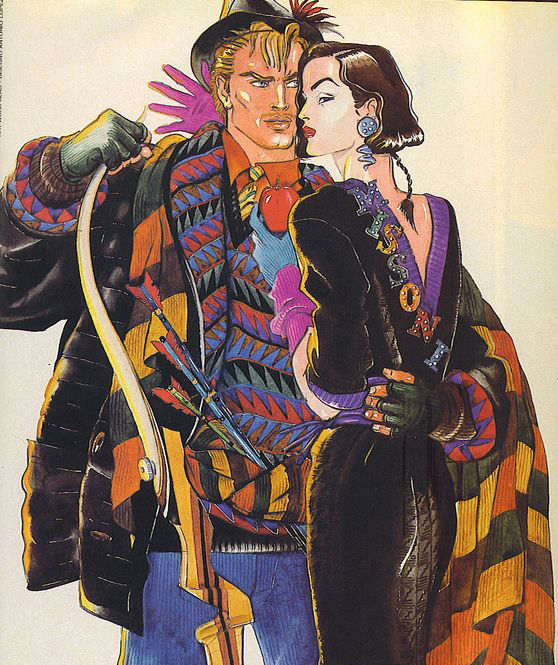No Products in the Cart
GIF by Przemek Sobocki @ www.sobocki.com

GIF by Przemek Sobocki @ www.sobocki.com
Fashion design sketches are rough, unfinished drawings of clothing, and how they’re intended to interact with the human body. Sketching is basically adding realism to the conceptual appeal of designs, it’s a way of communicating fashion ideas in a visual form. They may eventually become polished fashion drawings or remain scribbles in a designer’s sketchbook.
Fashion illustration has been around since clothes have been in existence, and a designer needed to document or translate a fashion idea. Apart from representing clothing designs, many fashion creations served as forms of art. Up to the rise of fashion photography in the late 1930s, illustrated magazine covers were the norm.

Artists frequently begin with a sketch of a figure called a croquis, which is a basic drawing of a model pose. The looks are built on top the croquis to understand how garments and poses interact with one another. The artist will typically find samples of fabrics or swatches, to imitate in their drawing. The goal is to draw in the pose that will show off your designs best.
Fashion design sketches are the first product that an apparel manufacturer selects before designing a complete product. The sketches are important for making selections of fabrics and materials to be purchased for making the clothes. Fashion sketches help a designer preview, plan, and explain their ideas, this process showcases creativity, and the uniqueness of the designer.
These illustrations try to capture movement, essence of feeling, and a portrayal of the person wearing the outfit. The drawings are not only a route to explain the figure to the manufacturer, but also a way to express the feelings and emotions the clothing intends to convey.

Illustration by Przemek Sobocki @ www.sobocki.com
Technology is developing at a rapid pace. In fashion design, model sketches and digital tools save time and promise precision over pencils and paper. These tools aid designers to maintain certain standards which can be preset, like brushes, stroke widths, and swatch libraries. They also foster a collaborative, connected design process among design teams who may be working from different places. Allowing designers to view virtual versions of finished products without purchasing materials also reduces waste.
However, like at U.Mi-1, some designers would rather stick to pencils and paper. This could be attributed to how they learnt fashion design drawing or their preference for working with something tangible. The poetry of hand sketches and the happy mistakes made along the way helps retain its appeal and makes the creation more natural and alive.
At U.Mi-1 we use design to not only to create the clothing but also to communicate the message of the collection to other members of the team. Some designers see sketching as a way of thinking visually before actually using the software for design work. Skill is a factor that inhibits some, because it takes time and effort to learn to use these tools. We believe the choice of methods is largely a question of personal preference after considering the tools at your disposal.
Our process at U.Mi-1 does not rely on digital or freehand design sketches. The most important part of creating of our clothing happens during the pattern cutting phase: the process of cutting out the individual pieces that make up a garment. Gozi Ochonogor, our Creative Director, is a skilled pattern cutter and she personally creates the original layouts for each of our creations. Constructing a pattern allows her to think of the garment in 3D. It’s an organic design process that allows not only for creation, but also discovery of interesting forms and style lines, which would be overlooked if directly following the sketch. This process sets U.Mi-1 apart making our clothing all the more unique.

Everything needs to have a digital copy these days, that gives an edge to digital tools, however, a scanned copy of a hand-drawn sketch also does the trick. Fashion sketches are the means of creating a unique niche in today’s competitive fashion industry, and it’s important to stay ahead of the curve.
3D visualization of sketches gives an abundance of options for lighting, materials, and backgrounds. Luxury brands are predicted to release digital clothing for pre-order before they are made and use interactive tools like AR&VR to showcase them to their customers. This calls to mind I.T Hong Kong’s collaboration with Fabricant where they created a digital collection, and showed them in pop-ups as 3D-rendered still images.

The use of artificial intelligence (AI) in fashion forecasting, pattern recognition, and social media reading, point to the possibility of an independent AI fashion designer. Amazon already has something of sorts, an algorithm that analyzes many images, copies the styles, and applies it to new items.
Online personal shopping service Stitch Fix is on a similar course, it’s CAO (Chief Algorithm Officer) claims that “The AI identifies fashion styles that customers prefer and would like to buy but aren’t designed or available yet” although human designers are still required to assess and improve the AI’s proposals.

Looking at the CAD tools we have today, from Adobe Illustrator, CLO 3D, Cinema 4D, to simplified apps like Canva, it’s hard to not see machines being programmed to draw fashion design sketches on their own. We firmly believe there will be AI designers in the future. How will that affect human designers you might ask?
AI does not design clothes from scratch, it imitates things, and is guided by human designers, because when it comes to designs that are creative, intricate, never seen before, AI is still far far away from that level of creativity.
We think AI will be best employed as an assistant to a fashion designer, giving the designer access to a wide pool of data to make better choices. Providing vast information on fabric, color combinations, new trends, sustainable fabric combinations, and other things that would take a regular assistant forever to sift through.